
Can a saliva test be used for diagnosing Lupus?
Lead: Ting Zhang
Team Members: Yong Du, Qingqing Wu, Hao Li, Gabriel Gidley, Thao Nguyen, Valeria Duran
Collaborator: Dr. Petri
Project Summary:
An Anti-nuclear antibody (ANA) titer of ≥1:80 or at least one equivalent positive test is the minimum criterion for systemic lupus erythematosus (SLE) diagnosis. While saliva has emerged as a tool for non-invasive assessment of patient health, ANA has not been assayed in saliva of SLE patients. We collected saliva samples from SLE patients, and assayed salivary ANA using immunofluorescence (IF) and enzyme-linked immunosorbent assay (ELISA). We observed that the salivary ANA IF intensities were significantly higher in SLE patients than in healthy controls, irrespective of SLE patient disease activity, and strongly correlated with serum ANA titers. Salivary IgG-ANA, IgA-ANA, and IgM-ANA levels were significantly increased in both active and inactive SLE patients compared with healthy controls, and levels of each isotype were significantly correlated with serum ANA titer, as partly shown in the Figure. Salivary IgM-ANA levels correlated with the physician global assessment, SLE disease activity index (SLEDAI), and serum C3 and C4. Salivary IgG-ANA also correlated with erythrocyte sedimentation rate, SLEDAI, and serum C3. Thus, our results indicate the potential of measuring salivary ANA and ANA isotypes as a point-of-care assessment for serum ANA titer and SLE disease status.
What is already known in the field?
- ANA, diverse autoantibodies targeting nuclear and cytoplasmic cell components, are the serological hallmarks of SLE and are present in 95–99% of SLE patients. ANA is a sensitive SLE screening test.
- Saliva, a readily accessible body fluid, has emerged as a tool for non-invasive assessment of patient health. ANA has not been assayed in saliva of SLE patients.
What is new?
- Salivary ANA and ANA isotypes in SLE patients were strongly correlated with serum ANA titer.
- Salivary ANA isotypes, particularly IgM-ANA and IgG-ANA, was associated with several SLE disease activity indices including serum C3 and SLEDAI.
Why is this important?
- Given saliva samples are easy to obtain, the main utility of salivary ANA is in point-of-care testing and screening. Salivary ANA and ANA isotypes could be measured to reflect serum ANA and SLE disease status as a point-of-care assessment.
Ongoing/future steps:
- To validate our results in larger cohorts of SLE patients from diverse ethnicities.
- To measure salivary anti-dsDNA antibodies and its correlation with serum biomarkers, and to explore the utility of salivary autoantibodies in disease evaluation of SLE.